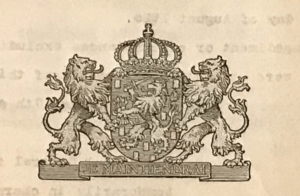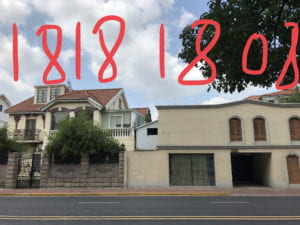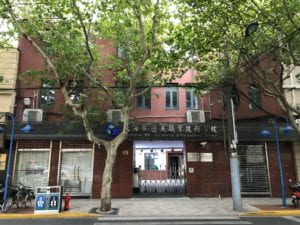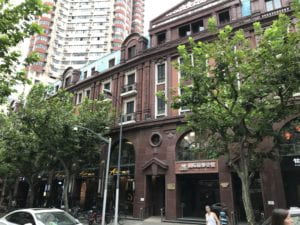I have this list with names of Hungarian nationals and their Shanghai addresses from 1940. “Avenues”, “Rues”, “Lanes”, “Routes”, “Apartments” and “Terraces”, that wouldn’t show up in a Google Map-search, let alone in its Chinese counterpart Baidu Map (百度地图). These French and English designations – symbols of a past era, are long gone. “Avenue Joffre”, “Rue Cardinal Mercier” or “Grosvenor Gardens” are all renamed in Chinese thus could be quite painful to be found, unless you have a guide. Fortunately, a road name-index in Paul French’s The Old Shanghai A-Z can make your life much easier, not to mention the great digital databases like ‘Virtual Shanghai‘ or the ‘Shanghai Art Deco Building Database‘. These sites document the city’s historic architecture, one that has been changing so much in the recent decades of booming urban constructions.
Equipped with the necessary information, I decided to take a walk on a sunny Saturday morning in the city’s former French Concession-area (法租界) to discover these old residences. I wanted to find out whether these locations listed in my 1940 source would still lead me to the homes of the people that once lived there ca. 79 years ago. I have to say that sometimes I found only missing house numbers or gigantic malls that sell high-end fashion on the supposed spot, like in the case of the Viennese ‘Fiaker Café & Restaurant’ I wrote about in my previous post. Luckily though, more often than not I was able to take photos of some of the beautiful buildings that once hosted Shanghai’s Central European community. Stick around for the map and the photos after the quick textual introduction to the source!
The seal of the Kingdom of the Netherlands on a consular document from the 1930s (Hungarian National Archives)
First of all, what is this list? The Hungarian National Archives’ Foreign Ministry Archives in Budapest (Magyar Nemzeti Levéltár, Külügyminisztériumi Levéltár [MNL KML]), holds some of the official documentation of the diplomatic sites that were in charge of Hungarian interests in China. You would probably expect that these were the Hungarian embassy and consulates, but actually between 1918 and 1943 that wasn’t the case. After the dissolution of the Habsburg Monarchy, no direct diplomatic relation was established between the two young republics. But who then? A long-time neutral country, The Kingdom of the Netherlands had been representing Austro-Hungarian interests in China since 1917 (when the latter joined the Entente and declared war on the former), and carried on doing so for both Austria and Hungary as they became small nation-states following the Paris Peace Treaties in 1919.
After the 1938 annexation of the Alpine country, the Dutch diplomats remained responsible only for people from the Eastern side of the Leitha River. That is to say, people in China who held Hungarian citizenship and registered at the local consular site, had their names appear on these lists. The Consulate General of The Netherlands in Shanghai (as well as the other Dutch consular sites like the ones in Beijing or Canton/Guangzhou) in cooperation with the local community leaders like Paul Komor, prepared these documents that contained further information about each individual’s home and work addresses, telephone numbers often with some additional information about their families. Following the Nazi invasion of the Benelux states in May 1940 these lists continued to be compiled annually by Komor and the authorities in charge. First it was Rome that took over the task from The Hague, only to hand it over in 1943 to the newly established Royal Hungarian Honorary Consulate run by the famous and respected architect László (Ladislav) E. Hudec. These lists provide us with previous information about the whereabouts of Shanghai’s Hungarian citizens, many of them refugees either from World War One POW camps or from Nazi-occupied Europe.
Using the 1940 list, I picked about two dozens of names, whose domiciles fell approximately close to each other, or at least could be walked through roughly on an East-West route across the French Concession. As you see below on the map a drew I started out walking on the arterial ex-Avenue Joffre currently called Huaihai Middle Road (淮海中路) to trek all the way down to Ferguson Lane/Wukang Road (武康路) where I sharply turned northeast and zig-zagged towards the Jing’An Temple (静安寺) area, where the “Badlands” started on Yu Yuan Road.
Le Béarn Apartments, 449-479 Avenue Joffre, today Huaihai Middle Road (淮海中路)
Apartment 56: Andor Emődi, b. in Budapest 1889; arrived at Shanghai in 1934; real estate agent and several manufacturers’ representative; secretary of the Hudec-led Shanghai Hungarian Association. Spouse: Ida Poriszka P.F. Erdő M.D., b. in Budapest 1901; arrived at Shanghai in the same year.
Grosvenor Gardens, Rue Cardinal Mercier, today Maoming Road (茂名路)
Apartment 229 C: Alexander Renner M.D., b. in Budapest 1884; graduated in Budapest, member of Budapest League of Physicians (Királyi Orvosi Egyesület) arrived at Shanghai in 1920 as an ex-refugee prisoner of war (POW) from Russia. Had medical praxis on 11 Nanking Road (南京路). Spouse: Teresa Grünfeld, b. in Szenicze, Hungary [today Senica, Slovakia] 1892. Son: Gábor Victor, b. in Budapest 1913.
Apartment 241 – B: Alfred Peter Lusztig, M.D., arrived at Shanghai in 1933.
Apartment 1202: Frederic Pór.
927, 933, 937 Avenue Joffre, today Huaihai Middle Road (淮海中路)
The respective numbers most probably refer to different lanes or ‘longs’ (弄) in Chinese, the common basic units of Shanghai’s urban structure, opening from the main roads/streets. However, the façade-building standing currently directly on the road might have replaced the original edifice. The photos show the worn buildings of the lanes, behind the forefront-building. Note the fading imprint on the top of the grey firewall (circled with red), that reminds us the Jerusalem Cross or the Georgian flag. I wonder if someone has an idea that explains its presence there…
lane 927: Charles (Károly) Liebeskind, b. in Bremen (?) 1913; married in 1919; arrived at Shanghai via Budapest in 1939.
lane 933: Emery (Imre) Gál M.D., b. in Budapest 1911; arrived at Budapest in 1939.
lane 937 : Éva Lichtenstädter, b. in Nagykanizsa (Hungary) 1920; arrived at Shanghai in 1938(?).
1810 Avenue Joffre, today Huaihai Middle Road (淮海中路)
This house number seems to be absent in the current numbering. As marked with red, the two neighboring houses are ‘1818’ and ‘1808’.
Imre Szekeres, b. in Budapest 1910; arrived at Shanghai in 1939; worked at North China Daily News. Spouse: Lívia Saphier, b. in Budapest 1912.
George (György) Szekeres, b. in Budapest 1911; arrived at Shanghai in 1939; engineer worked at Shanghai Leather Co. Spouse: Esher (Eszter) Klein, b. in Budapest 1910. Son: Peter, b. in Shanghai 1940.

Willow Court, 34 Rue Boissezon today Fuxing West Road (复兴西路)
Aladár Sátor, b. Schatz in Budapest 1891; arrived at Shanghai in 1921, most probably as an ex-refugee POW from Russia. Committee Member of the Hudec-led Shanghai Hungarian Association. Owner of the ‘A. Sator Co. (上海萨图洋行)’ import-export company. Spouse: Maria Petrovna Filinowa, b. in Achinsk (Russia) 1902.
Géza Sátor, b. Schatz in Budapest 1894; arrived at Shanghai in 1928; merchant. Spouse: Charlotte Engel, b. in Pécs (Hungary) 1905.
433 Avenue Haig, today Huashan Road (华山路)
Whether the building can be seen in the photo is the one that was once home for Charles H. Gonda is uncertain, in fact most probably the original one was demolished (or at least redesigned) and replaced by the current edifice.
Charles (Károly) H. Gonda, b. Goldstein in Gyöngyös (Hungary) 1889; arrived at Shanghai in 1920 as an ex-refugee POW from Russia; architect, designed numerous buildings in Shanghai. Married in Vladivostok 1919; spouse: Evdokia Nikolayevna Dimitriev, b. in Russia 1889.

270-272 Yu Yuan Road, today Yuyuan Road (愚园路)
270: George (György) Koppány, b. in Budapest 1896; arrived at Shanghai in 1921 most probably as an ex-refugee POW from Russia; married in Shanghai 1932; spouse: Maria Archinikoff, b. in Harbin 1911. Son: Louis, b. in Shanghai 1933.
272: Tibor De Mihály, b. in Kolozsvár [today Cluj Napoca in Romania] 1888; arrived at Shanghai in 1939 most probably as an ex-refugee POW from Russia; married in Mukden (today Shenyang 沈阳 in China); spouse: Vera Kozrnatovich, b. in Kobryn, Russia [today Poland] 1900. Son: László, b. in Harbin 1923.
272: Stella Silmann-Szirmay, b. in Bátonyterenye 1909; arrived at Shanghai in 1938; proprietor of restaurant and night club ‘Hungaria’ at 272 Yu Yuan Road.

749 Yuyuan Road (愚园路)
The photos below aren’t depicting Éva Komor’s residence ‘House 9’, as by the time of my visit I wasn’t able to find the building in question. Nevertheless, the photos were all taken in lane (long 弄) 749.
House 9: Éva Komor, b. in Budapest 1928. Any relation to relief-activist Paul Komor and his renowned Hungarian trader-family has not established at this time.
















Leave a Reply
You must be logged in to post a comment.